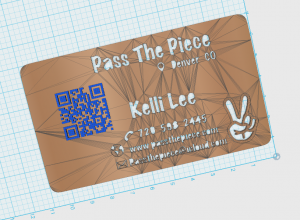Unique Business Cards with an Enormous Environmental Impact.

~ by Kelli Lee on September 09, 2016
Last week we briefly covered 3D printing for small business owners. Now you may be wondering..
Just what, if any, are the environmental impacts of 3D printing? The answer may be surprising, but first we need to understand what 3D printers can actually print and the route by which they accomplish this.Since the introduction of 3D printing in the 1980's, the constant evolution now allows for printing a variety of materials:
- Wood and glass
- Concrete or plastic
- Metal, carbon fiber and more.
- As a small example, there are more than 20 filament variations for a standard Fused Deposition Modeling (FDM) 3D printer you could easily find hobbyists, small business owners or even corporations using.
The environmental contributions are affected by the variables accompanying 3D printing, but some things we know for certain.
Companies such as 3D Fuel and Algix have been working on transforming abundances of harmful algae into filaments we could all use for 3D printing. Believe it or not they've recently accomplished this by releasing Algae-fuel, a filament for consumer purchase displaying itself in a variety of more than 6 colors!This, however, is nowhere near the only truly astonishing eco-friendly use!
An industry standard filament Polylactic Acid or Polylactide (PLA) is widely used for its many positive attributes.- Referred to as a bio-plastic or biodegradable thermoplastic.
- PLA generally requires less energy to print and manufacture.
- It is less toxic to those in the immediate environment but also to the Earth, due to its natural composition being derived from renewable resources, such as corn starch, tapioca roots, chips or starch, or sugarcane.
- PLA is water soluble
- Will break down naturally over time, at temperatures greater than 140* F or at a composting facility within 45-90 days.
Compare this plastic to its petroleum based ancestors and you'll soon realize biodegradable plastics have a solid foundation in shaping our future!
With kickstarters paving their way, there a quite a few promising compostable, biodegradable and recyclable 3D printing elements hitting the consumer market!
3D printing Energy consumption:- 3D printing may have its immediate downside but that doesn't mean this is a permanent restriction!
- A study at the Michigan Technological University found that making items with a basic 3D printer took 41%-64% less energy than making them in a factory and shipping them to the US.
- It is even possible to 3D print solar panels! That's right... solar panels are currently 3D printed in different regions to provide affordable electricity for rural areas!
Interesting use of 3D printing:
- Chinese companies use 3D printing to build houses!
- Italian company, WASP, who has created the world's biggest 3D printer in order to build affordable housing and be utilized in disaster zones!
From an eco-friendly small business perspective, something as tiny and seemingly innocent as business cards has quite serious environmental consequences.
What do I mean?- Staticticbrain calculates more than 27,397,260 business cards are printed daily!
- 88% of those being thrown out in less than a week!
If you just thought, what? Really? It gets worse.
Many businesses go for the extra professional touches supposedly supplied by plastic business cards. This doesn't simply stop with business cards however.Ever notice how much plastic you carry around with you personally?
- Debit cards, credit cards, water bottles, containers, membership cards, the list goes on!
- All of these have a limited lifespan before needing to be replaced!
- Each should be supplied with a plastic resin code, usually a number within a triangle somewhere on the product. Ranging from PVC which is environmentally detrimental in both manufacturing and distribution to a variety of plastics used today.
- One of many promising options for more eco-friendly plastic cards is PETG, 100% recyclable and non-gaseous.
What we can do:
It starts with awareness and knowledge, ultimately allowing you, as the consumer, to make informed decisions about the products you purchase, consume and dispose of. Some of these harmful plastics will be around for thousands of years, continually and exponentially declining the health of our natural world.Please make informed decisions and do not willingly knowingly contribute to the great pacific garbage patch!
In the end the reach of this technology is impeccable, from Nasa using 3D printing for rockets to entrepreneurs laying their claim through kickstarter, university students, professors, hobbyists and everyone in between. It appears as though the possibilities are limitless!
Could all of this indicate 3D printing in a green industrial revolution?
We would like to think so!
#3dprinting~ Pass The Piece Team